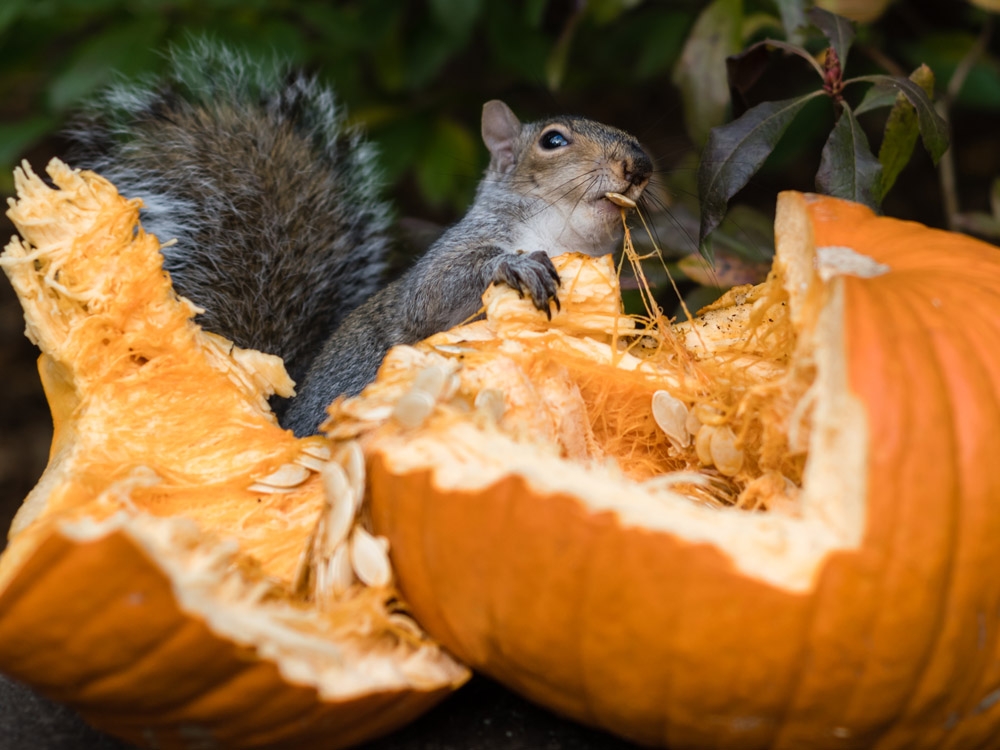
Gaping flesh wounds, guts festooned across a stoop. These common Spooky Season sights represent an epic battle between squirrels and pumpkin-havers over the fate of the festive gourd. Each October, critters turn lovingly selected pumpkins from seasonal decor to seasonal snack.
Sisters Jackie Paszinski and Nicki Wszelaki co-founded Piled Pumpkins, a pumpkin delivery and design service in northern New Jersey. The “number one question” customers ask is how to keep animals, squirrels and chipmunks especially, away from their carefully curated displays, Wszelaki said.
Here are suggestions from pumpkin display experts for how to make your gourds less appealing to squirrels. The good news is that you likely already have many of the ingredients you need.
Choose wisely: You want to select pristine pumpkins – no bruises or slices in the skin. As soon as Stephanie Nucci, the owner of Pumpkin City Porches in Washington D.C., acquires pumpkins, she washes them with a combination of water and vinegar. “That kills any mold spores and helps them to last longer throughout the season,” she says.
Animal repellent spray: Paszinski and Wszelaki include a small animal repellent spray as part of their pumpkin packages. “We always spray it down first, but then we encourage them to spray it down themselves after the next rainfall,” Paszinski says. The downside to this option: Humans must endure the same scent that deters critters.
Essential oils: More natural solutions promise a less putrid aroma. Essential oils such as lavender or eucalyptus, when mixed with water and sprayed on an autumnal display, can help do the trick, per Paszinski and Wszelaki.
Nucci swears by Mighty Mint, a rodent repellent made with peppermint extract. You could DIY a minty solution by adding peppermint oil to a spray bottle filled with water. She also suggests nestling peppermint balls in your display to amp up that smell, which rodents dislike. (Yes, it does mean having a decidedly wintry fragrance tangled up in your fall display.)
Pepper: Another solution you can find in your spice cabinet is pepper, especially cayenne. You could either sprinkle it directly onto the pumpkin, or mix it with water in a spray bottle, Wszelaki says. You could even use hot sauce.
Toiletries: Travel to your bathroom for additional repellents: grated Irish Spring soap (they don’t like the smell), hair spray (they don’t like the stickiness) or petroleum jelly (they don’t like the taste or texture).
Skip the corn husks: Some tricks involve what you don’t put in your display. Paszinski and Wszelaki suggest avoiding one popular fall decorating accent, the dried corn stalk. Squirrels and other critters love to munch on the corn, so including it will make your porch more appealing. If you simply can’t resist the aesthetic allure of the corn stalk, take out the cob or at least the kernels before adding it to your vignette.
Cull your pumpkin herd: Be vigilant about gourds in your display that are meeting their maker ahead of schedule. “If you do have a pumpkin that’s getting a little old or a little bit mushy on your porch, I would remove that to avoid the others also being eaten,” Paszinski says.
Hold off on carving: Resist the urge to convert your pumpkins into jack-o’-lanterns too early. Carved pumpkin will attract more critters, because you’ve done all the hard work in revealing the delicious squash meat. Plus, cutting into it will hasten its rotting. So if you want your Jack-o’-lantern to grin rather than crumble during trick-or-treating, wait until a few days before the 31st to start stabbing.
All of these tips can help. Unfortunately, though, whether squirrels target your stoop can sometimes come down to “the luck of the draw,” Nucci says. “It’s just nature being nature. Pumpkins are a natural produce and then squirrels are gonna eat them.”




